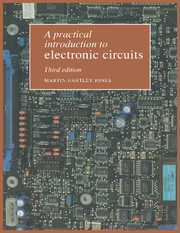Book contents
- Frontmatter
- Contents
- Preface to the third edition
- Preface to the second edition
- Preface to the first edition
- 1 Amplification and the transistor
- 2 The field-effect transistor
- 3 Thermionic valves and the cathode-ray tube
- 4 Negative feedback
- 5 Impedance matching
- 6 Semiconductor device characteristics
- 7 Amplification at high frequencies
- 8 Low-frequency signals, d.c. and the differential amplifier
- 9 Power supplies and power control
- 10 Pulse handling and time constants
- 11 Integrated circuit analogue building bricks
- 12 Positive feedback circuits and signal generators
- 13 Digital logic circuits
- 14 Microcomputer circuits and applications
- Appendix 1 Component identification
- Appendix 2 Transistor selection
- Appendix 3 Op amp data
- Appendix 4 Digital IC connections
- Appendix 5 Interfacing to the PC
- Bibliography
- Index
11 - Integrated circuit analogue building bricks
Published online by Cambridge University Press: 05 June 2012
- Frontmatter
- Contents
- Preface to the third edition
- Preface to the second edition
- Preface to the first edition
- 1 Amplification and the transistor
- 2 The field-effect transistor
- 3 Thermionic valves and the cathode-ray tube
- 4 Negative feedback
- 5 Impedance matching
- 6 Semiconductor device characteristics
- 7 Amplification at high frequencies
- 8 Low-frequency signals, d.c. and the differential amplifier
- 9 Power supplies and power control
- 10 Pulse handling and time constants
- 11 Integrated circuit analogue building bricks
- 12 Positive feedback circuits and signal generators
- 13 Digital logic circuits
- 14 Microcomputer circuits and applications
- Appendix 1 Component identification
- Appendix 2 Transistor selection
- Appendix 3 Op amp data
- Appendix 4 Digital IC connections
- Appendix 5 Interfacing to the PC
- Bibliography
- Index
Summary
Introduction
The integrated circuit (IC) is clearly the building brick of electronic circuits. We have already had a flavour of IC applications when looking at power supply regulators. Now we turn towards the full range of IC capabilities. A glance through a component distributor's catalogue reveals a seemingly limitless range of ICs for virtually every conceivable function. An IC may contain from a dozen transistors to a million depending on the application, together with all necessary resistors, diodes etc. The intimate thermal connection achieved by fabricating all the components on one chip of silicon generally leads to excellent stability and predictability in use.
The understanding of discrete components gained from earlier chapters will be found essential to the proper interfacing of ICs: in fact even today very few analogue circuit applications dispense totally with discrete semiconductors. However, the IC designer has today relieved the circuit designer of much of the ‘donkey work’. In addition, the small size and low power consumption of ICs has made possible products like the Camcorder and hand-held GPS position-fixing satellite receiver.
This chapter deals with applications of linear ICs. They are designed to handle analogue signals, which carry their information in terms of amplitude and waveshape. Most audio and radio signals come into this category; they are distinct from the standard binary pulses of digital circuits which are discussed in chapter 13.
- Type
- Chapter
- Information
- A Practical Introduction to Electronic Circuits , pp. 272 - 343Publisher: Cambridge University PressPrint publication year: 1995



